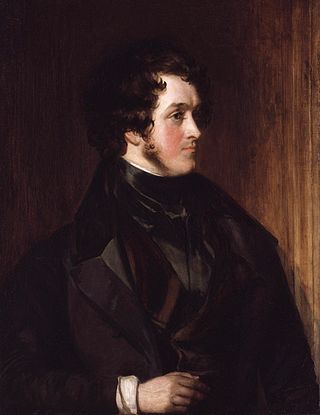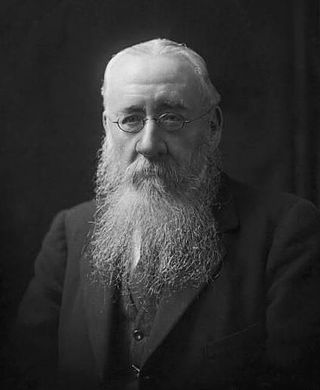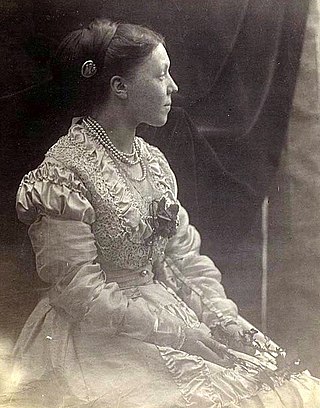Related Research Articles

William Makepeace Thackeray was an English novelist and illustrator. He is known for his satirical works, particularly his 1847–1848 novel Vanity Fair, a panoramic portrait of British society, and the 1844 novel The Luck of Barry Lyndon, which was adapted for a 1975 film by Stanley Kubrick.

Vanity Fair is a novel by the English author William Makepeace Thackeray, which follows the lives of Becky Sharp and Amelia Sedley amid their friends and families during and after the Napoleonic Wars. It was first published as a 19-volume monthly serial from 1847 to 1848, carrying the subtitle Pen and Pencil Sketches of English Society, which reflects both its satirisation of early 19th-century British society and the many illustrations drawn by Thackeray to accompany the text. It was published as a single volume in 1848 with the subtitle A Novel without a Hero, reflecting Thackeray's interest in deconstructing his era's conventions regarding literary heroism. It is sometimes considered the "principal founder" of the Victorian domestic novel.

Sir Leslie Stephen was an English author, critic, historian, biographer, mountaineer, and an early humanist activist. He was also the father of Virginia Woolf and Vanessa Bell.
This article contains information about the literary events and publications of 1863.
This article contains information about the literary events and publications of 1848.
This article contains information about the literary events and publications of 1847.
This article contains information about the literary events and publications of 1840.

William Harrison Ainsworth was an English historical novelist born at King Street in Manchester. He trained as a lawyer, but the legal profession held no attraction for him. While completing his legal studies in London he met the publisher John Ebers, at that time manager of the King's Theatre, Haymarket. Ebers introduced Ainsworth to literary and dramatic circles, and to his daughter, who became Ainsworth's wife.

George Edward Bateman Saintsbury, FBA, was an English critic, literary historian, editor, teacher, and wine connoisseur. He is regarded as a highly influential critic of the late 19th and early 20th century.
Catherine Ann Crowe, née Stevens was an English novelist, a writer of social and supernatural stories, and a playwright. She also wrote for children.

Anne Isabella, Lady Ritchie, eldest daughter of William Makepeace Thackeray, was an English writer, whose several novels were appreciated in their time and made her a central figure on the late Victorian literary scene. She is noted especially as the custodian of her father's literary legacy, and for short fiction that places fairy tale narratives in a Victorian milieu. Her 1885 novel Mrs. Dymond introduced into English the proverb, "Give a man a fish and you feed him for a day; teach a man to fish and you feed him for life."
The Newgate novels were novels published in England from the late 1820s until the 1840s that glamorised the lives of the criminals they portrayed. Most drew their inspiration from the Newgate Calendar, a biography of famous criminals published during the late 18th and early 19th centuries, and usually rearranged or embellished the original tale for melodramatic effect. The novels caused great controversy, and drew criticism in particular from the novelist William Makepeace Thackeray, who satirised them in several of his novels and attacked the authors openly.
Francis Thackeray (1793–1842) was a Church of England clergyman and author.
Artist and the Author is a pamphlet written by George Cruikshank in 1872. During the late 1860s, Cruikshank claimed to be the author of works attributed to other writers, including Charles Dickens and William Harrison Ainsworth. After John Forster contradicted Cruikshank's claims to having "originated" Oliver Twist, Cruikshank began a dispute in The Times as being the creator of novels attributed to Ainsworth. After the newspaper stopped carrying the dispute, Cruikshank produced all of his claims in Artist and the Author, where he disputed his relationship to 8 of Ainsworth's novels.

Jack Sheppard is a novel by William Harrison Ainsworth serially published in Bentley's Miscellany from 1839 to 1840, with illustrations by George Cruikshank. It is a historical romance and a Newgate novel based on the real life of the 18th-century criminal Jack Sheppard.
St. James's is a novel by William Harrison Ainsworth serially published in 1844. It describes the events surrounding the end of Queen Anne's reign and the dispute between the Duke and Duchess of Marlborough with two Tories for influence over the queen.

The Virginians: A Tale of the Last Century (1857–59) is a historical novel by William Makepeace Thackeray which forms a sequel to his Henry Esmond and is also loosely linked to Pendennis.
Angus Bethune Reach was a 19th-century British writer, noted for both his journalism and fiction. He was an acquaintance of such contemporary novelists as William Makepeace Thackeray and Edmund Yates, and counted the journalist and novelist Shirley Brooks as his greatest friend.

Jane Octavia Brookfield was a literary hostess and writer, best known for her platonic friendship with William Makepeace Thackeray. She also wrote four novels; some critics have drawn parallels between the events in these novels and her relationship with Thackeray.
Juliet McMaster is a Canadian scholar of eighteenth and nineteenth-century English literature, a specialist in Jane Austen, and Full Professor at the University of Alberta.
References
- ↑ Harden, Edgar (2003). A William Makepeace Thackeray Chronology. Palgrave Macmillan UK. p. 45. ISBN 978-0-230-59857-7 . Retrieved 29 June 2016.
- ↑ Monsarrat, Ann. An Uneasy Victorian: Thackeray the Man, 1811-1863. London: Cassell, 1980, pp. 94-95.
- ↑ Peters, Catherine. Thackeray's Universe. New York: Oxford University Press, 1987, p. 86.
- ↑ Saintsbury, George. "Introduction." In The Oxford Thackeray. Edited by George Saintsbury. Oxford University Press, 1908, vol. 3, p. xi.
- ↑ Thackeray, William Makepeace. Catherine: A Story. Edited by Sheldon Goldfarb. Ann Arbor: University of Michigan Press, 1999, p. 131. ISBN 0-472-11041-1
- ↑ Goldfarb, Sheldon F. "Historical Commentary." In Catherine: A Story. Edited by Sheldon Goldfarb. Ann Arbor: University of Michigan Press, 1999, p. 146. ISBN 0-472-11041-1
- ↑ Barzun, Jacques and Taylor, Wendell Hertig. A Catalogue of Crime. New York: Harper & Row. 1971, revised and enlarged edition 1989. ISBN 0-06-015796-8
- ↑ Saintsbury, George. "Introduction." In The Oxford Thackeray. Edited by George Saintsbury. Oxford University Press, 1908, vol. 3, p. xii.
- ↑ Peters, Catherine. Thackeray's Universe. New York: Oxford University Press, 1987, p. 86.
